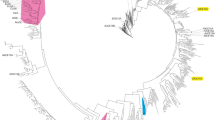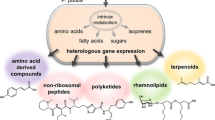Summary
The atp operon from the extreme alkaliphile Bacillus firmus OF4 was cloned and sequenced, and shown to contain genes for the eight structural subunits of the ATP synthase, preceded by a ninth gene predicted to encode a 14 kDa hydrophobic protein. The arrangement of genes is identical to that of the atp operons from Escherichia coli, Bacillus megaterium, and thermophilic Bacillus PS3. The deduced amino acid sequences of the subunits of the enzyme are also similar to their homologs in other ATP synthases, except for several unusual substitutions, particularly in the a and c subunits. These substitutions are in domains that have been implicated in the mechanism of proton translocation through F0-ATPase, and therefore could contribute to the gating properties of the alkaliphile ATP synthase or its capacity for proton capture.
Similar content being viewed by others
References
Bechhofer DH (1991) A method for sequencing polymerase chain reaction products can be used to sequence Bacillus subtilis “miniprep” plasmid DNA. BioTechniques 10:17–20
Bjorbaek C, Foersom V, Michelsen O (1990) The transmembrane topology of the a subunit from the ATPase in Escherichia coli analyzed by phoA protein fusions. FEBS Lett 260:31–34
Brandl CJ, Deber CM (1986) Hypothesis about the function of membrane-buried proline residues in transport proteins. Proc Natl Acad Sci USA 83:917–921
Brusilow WSA, Scarpetta MA, Hawthorne CA, Clark WP (1989) Organization and sequence of the genes encoding the protontranslocating ATPase of Bacillus megaterium. J Biol Chem 264:1528–1533
Capaldi RA, Vanderkooi G (1972) The low polarity of many membrane proteins. Proc Natl Acad Sci USA 69:930–932
Cozens AL, Walker JE (1987) The organization and sequence of the genes for ATP synthase subunits in the cyanobacterium Synechococcus 6301: Support for an endosymbiotic origin of chloroplasts. J Mol Biol 194:359–383
Del Sal, G, Manfioletti G, Schneider C (1989) The CTAB-DNA precipitation method: A common mini-scale preparation of template DNA from phagemids, phages or plasmids suitable for sequencing. BioTechniques 7:514–519
Devereux J, Haeberli P, Smithies O (1984) A comprehensive set of sequence analysis programs for the VAX. Nucleic Acids Res 12:387–395
Esser U, Krumholz LR, Simoni RD (1990) Nucleotide sequence of the F0 subunits of the sodium dependent F0F0 ATPase of Propionigenium modestum. Nucleic Acids Res 18:5887
Falk G, Walker JE (1988) DNA sequence of a gene cluster coding for subunits of the F0 membrane sector of ATP synthase in Rhodospirillum rubrum. Support for modular evolution of the F1 and F0 sectors. Biochem J 254:109–122
Fillingame RH (1990) Molecular mechanics of ATP synthesis of F1F0-type H+-transporting ATP synthases. In: Krulwich TA (ed) The bacteria. A treatise on structure and function, vol 12. Academic Press, San Diego
Guffanti AA, Hicks DB (1991) Molar growth yields and bioenergetic parameters of extremely alkaliphilic Bacillus species in batch cultures, and growth in a chemostat at pH 10.5. J Gen Microbiol 137
Guffanti AA, Susman P, Blanco R, Krulwich TA (1978) The protonmotive force and α-aminoisobutyric acid transport in an obligately alkalophilic bacterium. J Biol Chem 253:708–715
Guffanti AA, Finkelthal O, Hicks DB, Falk L, Sidhu A, Garro A, Krulwich TA (1986) Isolation and characterization of new facultatively alkalophilic strains of Bacillus species. J Bacteriol 167:766–773
Hicks DB, Krulwich TA (1986) The membrane ATPase of alkalophilic Bacillus firmus RAB is an F1-type ATPase. J Biol Chem 261:12896–12902
Hicks DB, Krulwich TA (1987) Purification and characterization of the F1 ATPase from Bacillus subtilis and its uncoupler-resistant mutant derivatives. J Bacteriol 169:4743–4749
Hicks DB, Krulwich TA (1990) Purification and reconstitution of the F1F0-ATP synthase from alkaliphilic Bacillus firmus OF4. Evidence that the enzyme translocates H+ but not Na+. J Biol Chem 265:20547–20554
Ivey DM, Krulwich TA (1990) Sequence of the gene encoding the ATP synthase beta subunit from alkaliphilic Bacillus firmus RAB. Nucleic Acids Res 18:1296
Ivey DM, Hicks DB, Guffanti AA, Sobel G, Krulwich TA (1990) The problem of the electrochemical proton potential in alkaliphilic bacteria. Mosbach Colloquium 41:105–113
Klionsky DJ, Brusilow WSA, Simoni RD (1983) Assembly of a functional F0 of the proton-translocating ATPase of Escherichia coli. J Biol Chem 258:10136–10143
Krulwich TA, Guffanti AA (1989a) Alkalophilic bacteria. Annu Rev Microbiol 43:435–463
Krulwich TA, Guffanti AA (1989b) The Na+ cycle of extreme alkalophiles: a secondary Na+/H+ antiporter and Na+/solute symporters. J Bioenerg Biomembr 21:663–677
Krumholz LR, Esser U, Simoni RD (1989) Nucleotide sequence of the unc operon of Vibrio alginolyticus. Nucleic Acids Res 17:7993–7994
Lewis MJ, Chang JA, Simoni RD (1990) A topological analysis of subunit a from Escherichia coli F0F0-ATP synthase predicts eight transmembrane segments. J Biol Chem 265:10541–10550
Maniatis R, Fritsch EF, Sambrook J (1982) Molecular cloning: a laboratory manual. Cold Spring Harbor Laboratory, Cold Spring Harbor, NY
Marmur J (1961) A procedure for the isolation of deoxyribonucleic acid from microorganisms. J Mol Biol 3:208–218
McCarn DF, Whitaker RA, Alam J, Vrba JM, Curtis SE (1988) Genes encoding the alpha, gamma, delta, and four F0 subunits of ATP synthase constitute an operon in the cyanobacterium Anabaena sp. strain PCC 7120. J Bacteriol 170:3448–3458
Miller MJ, Oldenburg M, Fillingame RH (1990) The essential carboxyl group in subunit c of the F1F0 ATP synthase can be moved and H+-translocating function retained. Proc Natl Acad Sci USA 87:4900–4904
Mitchell P (1961) Coupling of phosphorylation to electron and proton transfer by a chemi-osmotic type of mechanism. Nature 191:144–148
Needleman SB, Wunsch C (1970) A general method applicable to the search for similarities in the amino acid sequence of two proteins. J Mol Biol 48:443–453
Noumi T, Beltran C, Nelson H, Nelson N (1991) Mutational analysis of yeast vacuolar H+-ATPase. Proc Natl Acad Sci USA 88:1938–1942
Ohta S, Yohda M, Ishizuka M, Hirata H, Hamamoto T, OtawaraHamamoto Y, Matsuda K, Kagawa Y (1988) Sequence and over-expression of subunits of adenosine triphosphate synthase in thermophilic bacterium. PS3. Biochim Biophys Acta 933:141–155
Rhode M, Mayer F, Hicks DB, Krulwich TA (1989) Immunoelectron microscopic localization of the F1F0 ATPase (ATP synthase) on the cytoplasmic membrane of alkalophilic Bacillus firmus RAB. Biochim Biophys Acta 985:233–235
Senior AE (1990) The proton-translocating ATPase of Escherichia coli. Annu Rev Biophys Biophys Chem 19:7–41
Shyamala V, Ames GEL (1989) Genome walking by single-specificprimer polymerase chain reaction: SSP-PCR. Gene 84:1–8
Walker JE, Saraste M, Gay NJ (1984) The unc operon. Nucleotide sequence, regulation and structure of ATP-synthase. Biochem Biophys Acta 768:164–200
Zalkin H, Ebbole DJ (1988) Organization and regulation of genes encoding biosynthetic enzymes in Bacillus subtilis. J Biol Chem 263:1595–1598
Author information
Authors and Affiliations
Additional information
Communicated by J.W. Lengeler
Rights and permissions
About this article
Cite this article
Ivey, D.M., Krulwich, T.A. Organization and nucleotide sequence of the atp genes encoding the ATP synthase from alkaliphilic Bacillus firmus OF4. Molec. Gen. Genet. 229, 292–300 (1991). https://doi.org/10.1007/BF00272169
Received:
Issue Date:
DOI: https://doi.org/10.1007/BF00272169




